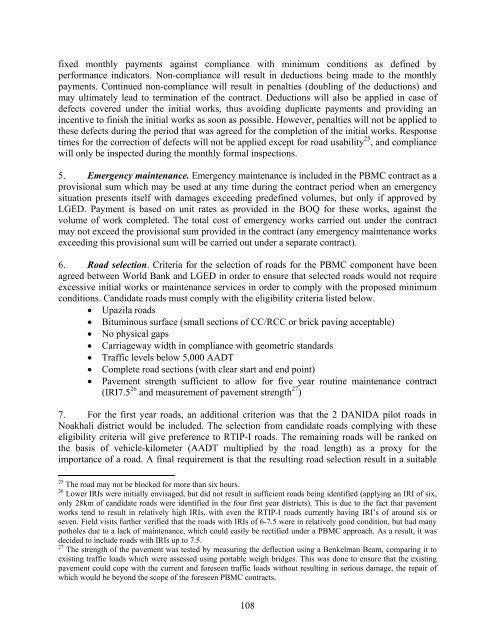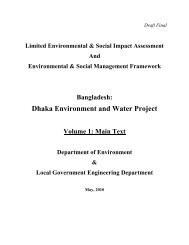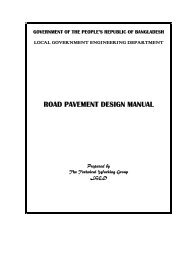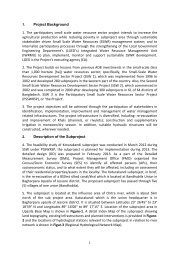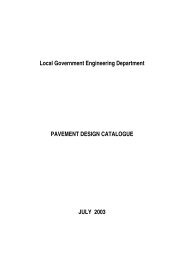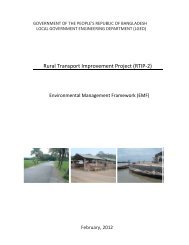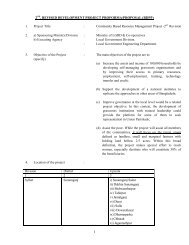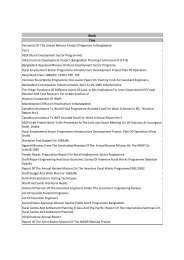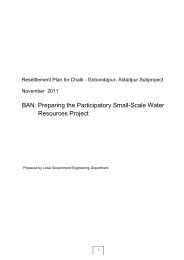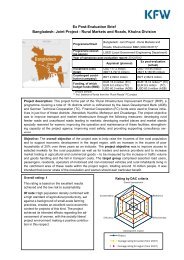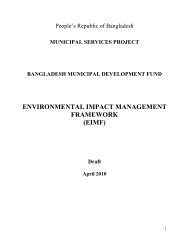PAD - LGED
PAD - LGED
PAD - LGED
You also want an ePaper? Increase the reach of your titles
YUMPU automatically turns print PDFs into web optimized ePapers that Google loves.
fixed monthly payments against compliance with minimum conditions as defined by<br />
performance indicators. Non-compliance will result in deductions being made to the monthly<br />
payments. Continued non-compliance will result in penalties (doubling of the deductions) and<br />
may ultimately lead to termination of the contract. Deductions will also be applied in case of<br />
defects covered under the initial works, thus avoiding duplicate payments and providing an<br />
incentive to finish the initial works as soon as possible. However, penalties will not be applied to<br />
these defects during the period that was agreed for the completion of the initial works. Response<br />
times for the correction of defects will not be applied except for road usability 25 , and compliance<br />
will only be inspected during the monthly formal inspections.<br />
5. Emergency maintenance. Emergency maintenance is included in the PBMC contract as a<br />
provisional sum which may be used at any time during the contract period when an emergency<br />
situation presents itself with damages exceeding predefined volumes, but only if approved by<br />
<strong>LGED</strong>. Payment is based on unit rates as provided in the BOQ for these works, against the<br />
volume of work completed. The total cost of emergency works carried out under the contract<br />
may not exceed the provisional sum provided in the contract (any emergency maintenance works<br />
exceeding this provisional sum will be carried out under a separate contract).<br />
6. Road selection. Criteria for the selection of roads for the PBMC component have been<br />
agreed between World Bank and <strong>LGED</strong> in order to ensure that selected roads would not require<br />
excessive initial works or maintenance services in order to comply with the proposed minimum<br />
conditions. Candidate roads must comply with the eligibility criteria listed below.<br />
• Upazila roads<br />
• Bituminous surface (small sections of CC/RCC or brick paving acceptable)<br />
• No physical gaps<br />
• Carriageway width in compliance with geometric standards<br />
• Traffic levels below 5,000 AADT<br />
• Complete road sections (with clear start and end point)<br />
• Pavement strength sufficient to allow for five year routine maintenance contract<br />
(IRI7.5 26 and measurement of pavement strength 27 )<br />
7. For the first year roads, an additional criterion was that the 2 DANIDA pilot roads in<br />
Noakhali district would be included. The selection from candidate roads complying with these<br />
eligibility criteria will give preference to RTIP-I roads. The remaining roads will be ranked on<br />
the basis of vehicle-kilometer (AADT multiplied by the road length) as a proxy for the<br />
importance of a road. A final requirement is that the resulting road selection result in a suitable<br />
25 The road may not be blocked for more than six hours.<br />
26 Lower IRIs were initially envisaged, but did not result in sufficient roads being identified (applying an IRI of six,<br />
only 28km of candidate roads were identified in the four first year districts). This is due to the fact that pavement<br />
works tend to result in relatively high IRIs, with even the RTIP-I roads currently having IRI’s of around six or<br />
seven. Field visits further verified that the roads with IRIs of 6-7.5 were in relatively good condition, but had many<br />
potholes due to a lack of maintenance, which could easily be rectified under a PBMC approach. As a result, it was<br />
decided to include roads with IRIs up to 7.5.<br />
27 The strength of the pavement was tested by measuring the deflection using a Benkelman Beam, comparing it to<br />
existing traffic loads which were assessed using portable weigh bridges. This was done to ensure that the existing<br />
pavement could cope with the current and foreseen traffic loads without resulting in serious damage, the repair of<br />
which would be beyond the scope of the foreseen PBMC contracts.<br />
108


